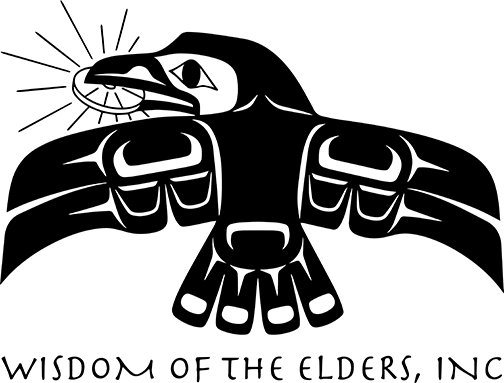Artist’s Circle: Corwin Clairmont
with Bruce Crespin
Arlie Neskahi:
The hearts and minds of native people and their ancestors are expressed in their art, be it beaded buckskin, cedar baskets or ceramic bowls. Contemporary tribal artists can draw from a greater variety of media than their ancestral peers. They may paint on canvas or work with photographs, metals, or natural materials, often connecting with tribal realities in subtle or ironic ways. In today’s Artist’s Circle, Bruce Crespin explores the work of Salish-Kootenai conceptual artist “Corky” Clairmont.
Corky Clairmont:
I’m not so much interested that they always agree with me in what they’re seeing. I don’t put work out that gives solutions but provokes questions.
Bruce Crespin:
Corwin Clairmont sits in his cluttered office at Salish-Kootenai College on the Flathead Indian Reservation. He opens an exhibit catalogue to a print displaying a portion of the Lewis and Clark trail. Multi-hued Indian moccasin foot prints cross the trail in all directions, while a few black boot prints heading one way are superimposed atop everything else. From 1991, this print series, “10,000 Years Indigenous People, 200 Years Lewis and Clark” looks at the “voyage of discovery” with an Indian “spin”.
Corky Clairmont:
The moccasin prints, if you look at that as kind of a metaphor to hard-soled shoes, you get a kind of a glimpse of the difference between the newcomers and the native communities. When you are wearing a pair of moccasins made out of soft deerskin, and you step on the earth, you feel the temperature of the earth. You feel the dampness. You feel the texture, the little stones. When you put on a hard pair of shoes and you step into the same places, you feel nothing.
Bruce Crespin:
Corwin, also known as Corky, was born at St. Ignatius, Montana. He started showing artistic promise early. At fifteen, he designed the official tribal seal, which is still used today. He completed studies at Montana State University, and earned a masters degree from California State University in Los Angeles. Staying in L.A. through the 70’s, he taught fine arts and directed programs at the Otis Art Institute. In much of his early work, he was already mixing media, as he examined and questioned U.S. culture with humor and irony.
Corky Clairmont:
I gravitated towards artists that were more issue oriented, that were doing art that said something about what was going on. I kind of liked that aspect. It seemed to be more participatory in life, and reflective of life.
Bruce Crespin:
Corky returned home to the Flathead Reservation in 1984 and began teaching at the tribal college. He continues to combine seemingly unrelated elements in his innovative art to better express a tribal point of view.
Corky Clairmont:
It’s work that I feel is educational and is not just for the native community, but is for everyone that might want to get a better understanding of our Indian people.
Bruce Crespin:
Clairmont’s 1993 mixed-media work, “Asphalt Storm Clouds Over the Reservation” is an example. In it, he comments on the proposed expansion of a highway that runs through the middle of the Flathead reservation. The piece is formed by four lodge poles, tied at the top to form a tipi frame. Inside the structure, book-sized chunks of broken black asphalt dangle over a platform. On the platform are aerial photos of the reservation along with landscape photos taken on the ground.
Corky Clairmont:
When you flood the piece with light, it casts shadows on top of the photographs, or what I refer to as “storm cloud images” on the photographs. And so, it’s an attempt to describe the asphalting of our lands.
Bruce Crespin:
Corky worked with other tribal activists to educate highway planners and make them more accountable for the natural elements of the landscape.
Corky Clairmont:
We were able to secure overpasses over waterways or pond areas that allowed the turtles and the smaller animals to easily get from one pond to the other without crossing the highway.
Bruce Crespin:
Corky’s 1993 painting “Paha Sapa ” simultaneously shows us the native and non-native views of Mt. Rushmore in the Sacred Black Hills of South Dakota. A non-Indian tourist family wears mirrored sunglasses that reflect images of the four presidents on Mt. Rushmore; at the same time, an Indian family’s sunglasses reflect four skulls.
In preparation for “ Time X for Northwest Indigenous Indian Peoples,” Corky himself followed the Lewis and Clark trail, from Bismark, North Dakota to Portland, Oregon. Corky subtitled this 2003 work, “ Indian discovers Lewis and Clark Artifacts. ” The piece looks like a Timex watch display case, filled with trinkets and commercial memorabilia from gift shops and visitors centers along the trail. Little tags identify each one, as in a museum.
Corky Clairmont:
And I really encourage everybody to be an artist. Each one of us has something that we can communicate through the arts. You can many times get your point across in kind of a non-threatening manner. So I feel everybody needs to be doing art. (chuckles)
Bruce Crespin:
For Wisdom of the Elders, I’m Bruce Crespin.


